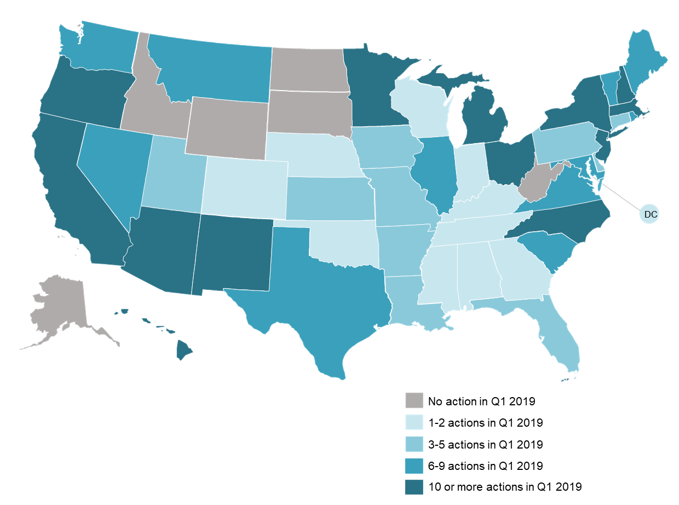The 50 States of Grid Modernization Report Update: U.S. Grid Modernization Activity More Than Doubles Within the Last Two Years
Raleigh, N.C. – (May 2, 2019) The N.C. Clean Energy Technology Center (NCCETC) released its Q1 2019 edition of The 50 States of Grid Modernization. The quarterly series provides insights on state regulatory and legislative discussions and actions on grid modernization, utility business model and rate reforms, energy storage, microgrids, and demand response.
The report finds that 44 states and the District of Columbia took actions related to grid modernization during Q1 2019 (see figure below), with the greatest number of actions relating to energy storage deployment, distribution system planning, data access policies, and utility business model reforms.
A total of 395 grid modernization actions were taken during Q1 2019, representing a 53% increase over Q1 2018 (259 actions) and a 167% increase over Q1 2017 (148 actions). New York, California, and Massachusetts took the greatest number of actions during the quarter, followed by Minnesota, New Jersey, Hawaii, and New Hampshire.
Q1 2019 Legislative and Regulatory Action on Grid Modernization

The report discusses three trends in grid modernization actions taken in Q1 2019: (1) regulators seeking greater realization of advanced metering benefits, (2) states incorporating energy storage into existing policies and incentive programs, and (3) efforts spreading to expand access to customer energy data.
“Grid modernization activity jumped up in Q1 2019, with a great deal of new legislation coming under consideration,” noted Autumn Proudlove, lead author of the report and Senior Manager of Policy Research at NCCETC. “The majority of the grid modernization bills being introduced relate to energy storage, with many states working to integrate storage into existing policy and incentive frameworks.”
The report notes the top five policy developments of Q1 2019 were:
- The New Hampshire Public Utilities Commission Staff releasing its final grid modernization report;
- The Oregon Public Utility Commission opening an investigation into distribution system planning;
- The Hawaii Public Utilities Commission Staff filing its performance-based regulation recommendations;
- Ameren Missouri proposing its $6.3 billion Smart Energy Plan; and
- Virginia regulators directing Dominion Energy to refile its grid modernization plan and Appalachian Power withdrawing its plan.
“We’re seeing a trend of regulators pushing utilities to consider the full potential of grid modernization investments,” observed David Sarkisian, Senior Policy Analyst at NCCETC. “For instance, several regulators have been questioning advanced metering infrastructure deployments when they are not accompanied by new programs or rate structures to maximize the benefits offered by the technology.”
View the 50 States of Grid Mod Q1 2019 Executive Summary
View and Purchase the 50 States of Grid Mod Q1 2019 update FULL Report
View other 50 States Reports – Solar, Grid Modernization and Electric Vehicles
ABOUT THE N.C. CLEAN ENERGY TECHNOLOGY CENTER
The N.C. Clean Energy Technology Center, as part of the College of Engineering at North Carolina State University, advances a sustainable energy economy by educating, demonstrating and providing support for clean energy technologies, practices and policies. It serves as a resource for innovative, sustainable energy technologies through technology demonstration, technical assistance, outreach and training. For more information about the N.C. Clean Energy Technology Center, visit: http://www.nccleantech.
MEDIA CONTACT: Shannon Helm, NCCETC, shannon_helm@ncsu.edu, 919-423-8340